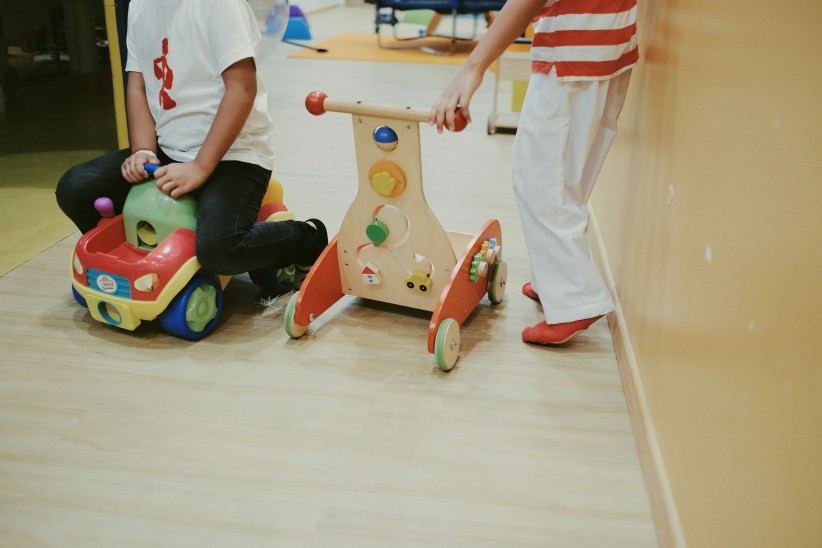 If you’ve got a little one at home who just won’t go to sleep, rest assured (pun intended): you’re not alone. In fact, it’s the desperation of so many new parents that inspired Conner Herman and Kira Ryan of the popular sleep consulting firm Dream Team Baby to write The Dream Sleeper: A Three-Part Plan For Getting Your Baby To Love Sleep (Jossey-Bass). The book is an invaluable resource for everything from the physiology of shuteye to concrete advice on how to ease a baby’s path to dreamland.
If you’ve got a little one at home who just won’t go to sleep, rest assured (pun intended): you’re not alone. In fact, it’s the desperation of so many new parents that inspired Conner Herman and Kira Ryan of the popular sleep consulting firm Dream Team Baby to write The Dream Sleeper: A Three-Part Plan For Getting Your Baby To Love Sleep (Jossey-Bass). The book is an invaluable resource for everything from the physiology of shuteye to concrete advice on how to ease a baby’s path to dreamland.
When did you first become interested in babies’ sleep patterns?
When our oldest children were babies we really struggled with sleep. We read countless books and tried every tip we heard, but nothing was working. Looking back, we both had “sensitive sleepers,” but at the time, we felt really confused and exhausted. So we hired an amazing group of pediatric experts and they helped us come up with a new approach to teaching children to not only sleep, but to love sleep. Once we knew we had a plan that worked, we set out to help [other] parents.
What inspired you to write The Dream Sleeper?
We founded Dream Team Baby [in 2007] and quickly had a very successful sleep consulting practice. Years later, we have so much demand that we can’t help people as quickly as we’d like. When parents want sleep help, they want help yesterday. So we put everything we tell our clients in our book.
At what age should babies typically be sleeping through the night?
Healthy, full-term babies are capable of sleeping through the night (11-12 hours) by four months of age. However, it doesn’t mean all four-month-olds magically start sleeping this way. While many babies seem to struggle with putting themselves to sleep or sleeping consistently, it doesn’t mean that they can’t learn to be sound sleepers.
What can affect a child’s ability to sleep through the night?
A lot of things. Hunger, sickness, immature sleep cycles, but the most common culprit is negative sleep associations—needing help from you or another outside source to go from awake to asleep.
What quick changes can be made to improve a child’s ability to sleep?
Revamping your child’s sleep environment, organizing daytime sleep and maximizing feedings during the day (to minimize the need to eat at night), and identifying your child’s sleep associations.
What are the advantages of a young child getting enough sleep vs. not getting enough?
Everything begins to break down when children do not get adequate amounts of sleep. Even if your child doesn’t seem to be excessively sleepy, insufficient amounts of sleep can still bubble up in a number of ways: behavioral problems, hyperactivity, irritability and decreased immunity.
At what age should most parents start sleep teaching?
Four to 24 months is the ideal time to sleep-teach your child. Before four months, some babies aren’t neurologically and physically capable of self-soothing, sleep rhythms aren’t fully developed, and their little bellies may not be capable of consuming all the calories during the daytime to sustain themselves for 11-12 hours of sleep. With a child two years or older, everyone’s habits are fully formed and fixing sleep usually requires a ton of focus from the parents on their relationship with their child as well as their child’s openness to change. It’s certainly not impossible but the process can be longer and more emotional.
What is involved in sleep training?
The key to sleep teaching is identifying your child’s negative sleep associations and replacing them with positive ones. If your child needs you in order to fall asleep at bedtime, you’ve become part of how he falls asleep. So it makes sense that your baby would believe the same would be true in the middle of the night… If you are ready for sleep teaching, mentally prepare yourself for it to be a two-week process. That doesn’t mean you’re going to have two weeks of intense nights. In fact, after the first few days, you and your baby will probably be pinching yourselves at how wonderful your new lives are already.

What do you need to do differently when sleep training a toddler as opposed to an infant?
It’s really important to prepare toddlers and preschoolers emotionally for sleep teaching. Doing things like reading books and acting out the new sleep situation with stuffed animals before making changes in your own situation can help your toddler feel more secure and comfortable with sleep teaching. Do these learn-through-play exercises for several days leading up to sleep teaching so your toddler has some time to process the idea of independent sleep.
Do siblings affect sleep training, or is there anything that you should do to prepare or involve them?
If possible, plan for the older sibling to spend a weekend away at the home of a close relative or friend during the initial days of sleep teaching. This way you can get the first few (potentially challenging) days out of the way and give your younger child extra attention without your older child feeling neglected. If the sibling can’t leave, make him or her feel needed. Have a conversation with your older children before sleep teaching to explain that their baby brother or sister is about to learn how to sleep like a big girl or boy. Also, preserve the older child’s sleep by keeping their schedule consistent and adding a white noise machine to their room.
Should parents involve babysitters and caregivers in the sleep training process?
Yes! To avoid sending your baby mixed messages that could cause confusion and possibly more sleep problems, it will be critical that all of your caregivers stay as consistent with your plan as possible. While we recommend that parents come up with the plan and implement it in the beginning, discussing the sleep-teaching plan with your babysitter and addressing any questions she may have before you begin will save everyone from stress.
What advice would you give parents who have been struggling with a child’s sleep problems for a long time?
We hope that anyone who is feeling guilty for doing all of the “wrong things” to get their child to sleep reads the book and feels reassured. Nothing is unchangeable.
Elisabeth Frankel Reed blogs regularly at www.newyorkfamily.com. She was born and raised in New York and loves exploring the city with her husband and two children, Brandon and Julia.






















